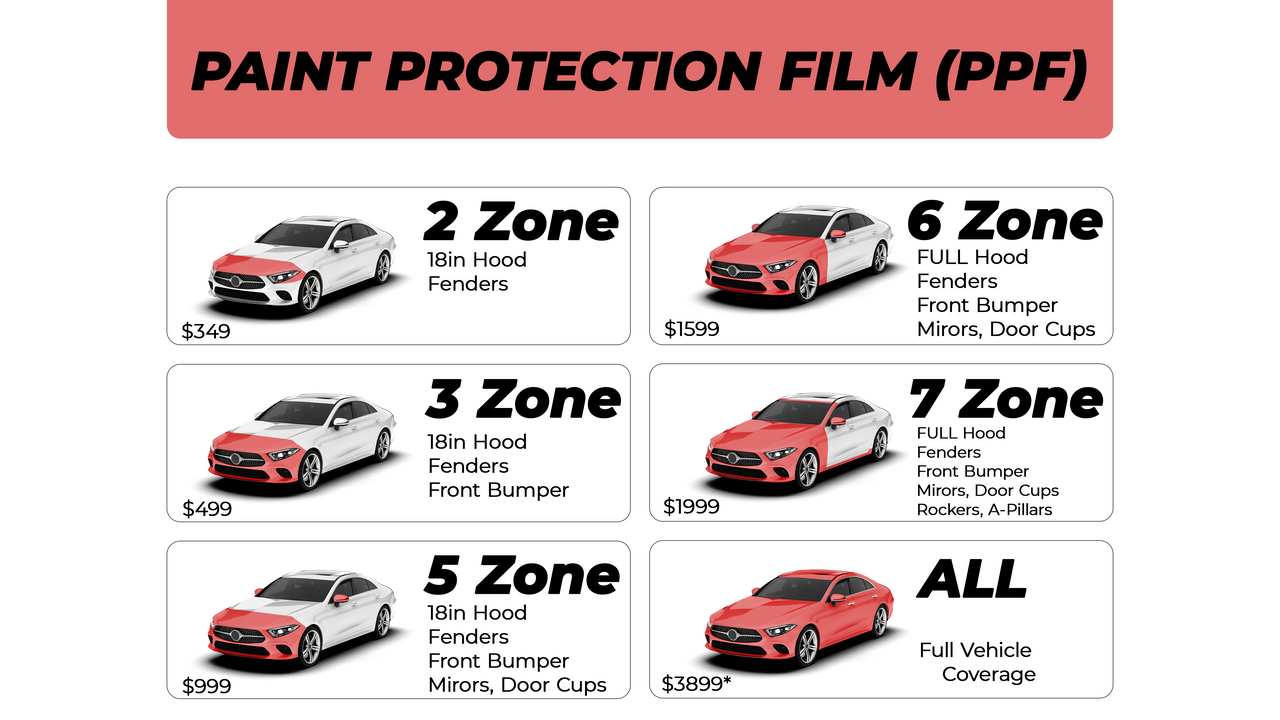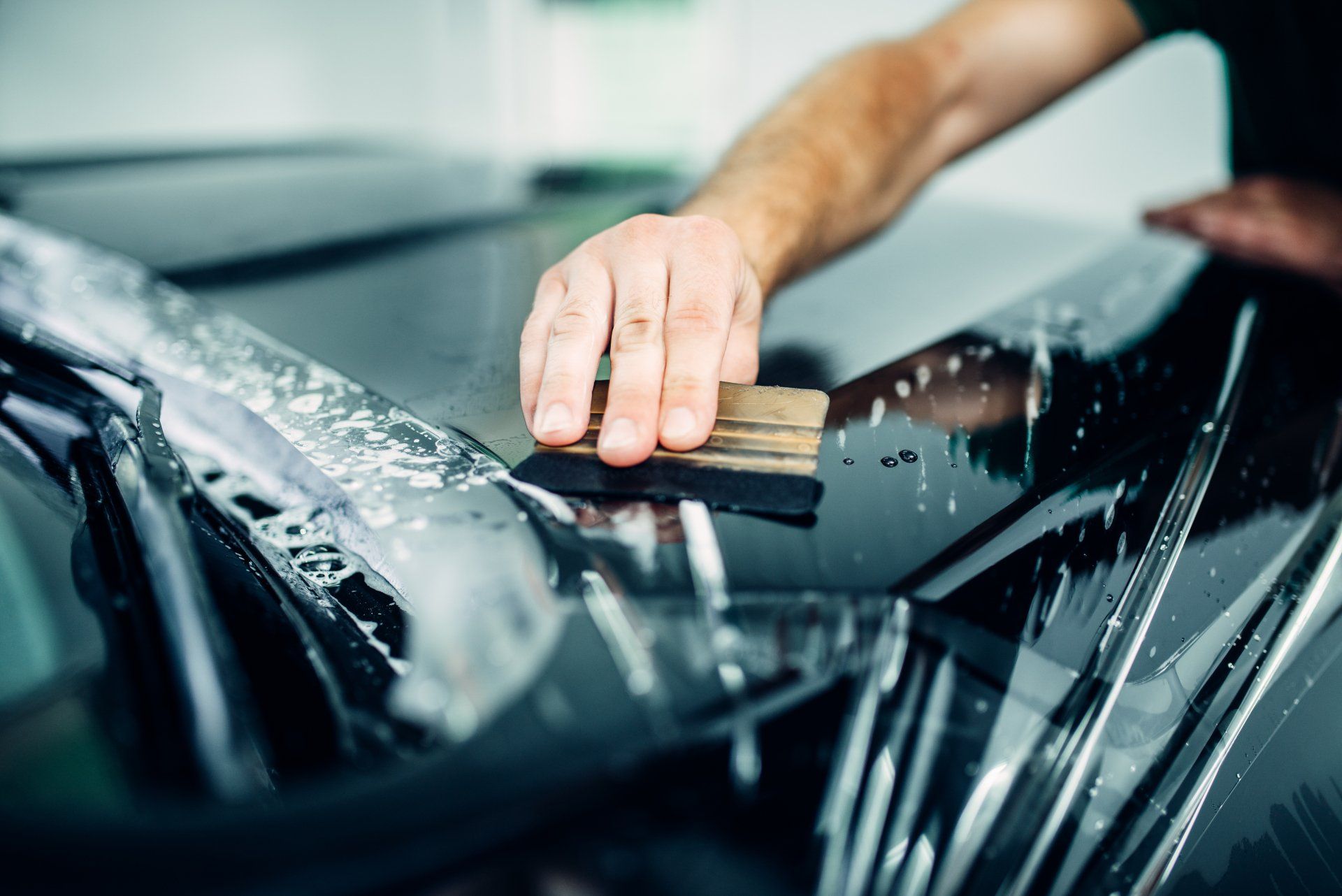Do’s and don’ts after applying SpeedEFX Paint Protection Film to your car
The Ultimate Overview to Understanding Paint Protection Film for Car Fanatics
Paint Protection Film (PPF) has come to be a crucial topic amongst vehicle lovers seeking to maintain their car's look. This sophisticated safety layer uses countless benefits, from protecting versus environmental dangers to maintaining resale value. Recognizing the different kinds of PPF, the application procedure, and maintenance suggestions can greatly affect one's financial investment. Numerous misconceptions linger. What are one of the most common myths, and just how do they contrast to other safety alternatives?
What Is Paint Protection Film (PPF)?
Paint Protection Film (PPF) functions as a transparent shield for automotive surfaces. This sophisticated polyurethane product is designed to adhere seamlessly to a car's outside, giving a safety layer versus various environmental dangers. PPF is commonly related to high-impact areas, such as hoods, bumpers, and mirrors, where scratches and chips are likely to occur.The film is incredibly resilient, supplying resistance versus UV rays, roadway particles, and chemical discolorations, which can weaken a lorry's surface in time. Its self-healing residential or commercial properties allow minor scratches to disappear with heat exposure, maintaining an immaculate appearance. PPF is available in various finishes, consisting of gloss and matte, to match various paint designs and preferences.Installation calls for accuracy, usually best done by specialists to assure a perfect application. On The Whole, Paint Protection Film is a cutting-edge remedy for auto fanatics looking for to protect their vehicle's visual allure while securing its surface stability.
Benefits of Making Use Of Paint Protection Film
While lots of vehicle fanatics prioritize looks, the sensible advantages of Paint Protection Film (PPF) are just as compelling. PPF works as a robust obstacle against different ecological dangers, including road particles, stone chips, and insect spots, effectively maintaining the vehicle's outside. Additionally, it uses UV defense, avoiding paint from fading and keeping the vehicle's vibrant shade over time.Another significant advantage is the self-healing residential properties of advanced PPFs, which can recuperate from small scrapes and swirl marks with heat exposure, making sure the coating remains excellent. Installation of PPF can additionally boost resale worth; potential buyers are usually attracted to well-maintained automobiles without noticeable blemishes. Additionally, PPF is very easy to clean and requires very little maintenance, enabling cars and truck fanatics to enjoy their cars without the anxiety of consistent maintenance. On the whole, PPF combines functionality with aesthetics, making it a useful investment for vehicle enthusiasts.
Different Sorts Of Paint Protection Film
Comprehending the numerous kinds of paint security movie is vital for automobile enthusiasts. Trick attributes such as self-healing modern technology, contrasts of density and durability, and application methods play a crucial role in selecting the right alternative. Each kind offers distinct benefits that accommodate different requirements and preferences.
Self-Healing Modern Technology Explained
Self-healing modern technology reinvents the method vehicle enthusiasts protect their vehicles from square one and small damage. This cutting-edge function is mainly located in advanced paint protection films (PPF) When subjected to heat from sunshine or a warm setting, the distinct polymers within these films soften, allowing little scratches and swirl marks to "recover" themselves. This self-repairing capability not just maintains the movie's aesthetic allure however additionally extends its safety top qualities. Various brand names offer various formulas of self-healing films, each with unique qualities customized to particular demands. Automobile fanatics appreciate this modern technology for its capability to maintain their vehicles looking excellent, reducing the regularity of fixings and guaranteeing a longer-lasting safety service versus day-to-day wear and tear.

Thickness and Durability Contrast
Density and sturdiness are essential elements when reviewing different types of paint security movie (PPF) PPF commonly varies in density from 6 mils to 12 mils, with thicker films supplying enhanced resistance to scrapes, chips, and environmental damages. Thinner films, while much less protective, usually offer much better quality and conformability, making them suitable for elaborate layouts and contours. Resilience varies among brand names and kinds; some films incorporate sophisticated products that improve their life-span and keep their look over time. Furthermore, self-healing residential or commercial properties in certain PPF types can better extend longevity by allowing minor scrapes to disappear with heat. Ultimately, the choice of thickness and sturdiness must line up with the certain needs and choices of the car fanatic.
Application Strategies Review
Selecting the appropriate application method is essential for optimizing the advantages of paint security film (PPF) There are various methods readily available, each matched to different choices and skill levels. One of the most usual methods include the traditional damp application, which utilizes a slip solution to promote positioning, and the completely dry application, which needs precision and experience for instant adhesion. In addition, progressed options like pre-cut packages use comfort, developed to fit specific vehicle versions, while bulk movie enables personalization but requires a lot more experience (SpeedEFX Paint Protection Film). Each strategy presents one-of-a-kind benefits and challenges, making it vital for automobile enthusiasts to pick one that straightens with their objectives and abilities, ultimately ensuring excellent security for their lorries
The Application Process of PPF
The application procedure of paint protection movie (PPF) includes numerous vital actions to ensure excellent results. Detailed surface prep work is essential, complied with by details installation methods that maximize bond and coverage. Finally, correct post-application care is required to maintain the movie's stability and look in time.
Surface Prep Work Steps
Proper surface preparation is essential for a successful paint protection film (PPF) application, as it straight impacts the film's adhesion and longevity. The preliminary step includes completely washing the lorry to eliminate dust, gunk, and various other pollutants. A pH-neutral car soap is recommended to avoid harming the paint. Adhering to the clean, the surface area needs to be dried out diligently with microfiber towels to stop water spots. Next off, any kind of existing imperfections, such as scrapes or swirls, have to be addressed, generally using a polish or substance. The surface should be cleaned down with an isopropyl alcohol solution to assure it is entirely tidy and cost-free from oils or deposits. This careful prep work lays the foundation for a successful PPF installment.
Installation Methods Discussed
Comprehending the application procedure of paint security movie (PPF) is important for achieving the very best outcomes. The installation typically starts with exact measurements of the vehicle's surfaces to guarantee correct insurance coverage. Cleanliness is paramount; the surface area should be without dirt, dirt, and pollutants. An installer frequently makes use of a slip option, which facilitates placing the film throughout application.The film is meticulously laid onto the surface area, utilizing tools like mops to remove air bubbles and excess remedy. Warm might be applied to adjust the film to complex contours and contours. Appropriate placement and tension are crucial for a seamless surface. Trimming excess movie assures a clean edge, finishing the installation procedure effectively and boosting the vehicle's looks and protection.
Post-Application Care Tips

Maintenance Tips for Long-Lasting Protection
How can cars and truck enthusiasts ensure their paint defense movie stays efficient gradually? Routine upkeep is important to protect the film's longevity and efficiency (SpeedEFX Paint Protection Film). To begin with, washing the lorry with a pH-balanced cars and truck shampoo aids protect against the accumulation of contaminants that can harm the film. Making use of a microfiber fabric for drying out is suggested to stay clear of scratches.Additionally, it is here crucial to avoid unpleasant cleaning tools or extreme chemicals, which can deteriorate the film's surface area. Applying a sealant or wax particularly developed for paint defense film can offer an extra layer of protection against UV rays and environmental elements.Furthermore, fanatics must routinely check the movie for any type of indicators of wear or damage, addressing problems without delay to preserve its safety top qualities. Auto parking in shaded areas or utilizing car covers can likewise decrease exposure to hazardous UV rays. By adhering to these maintenance suggestions, auto enthusiasts can ensure their paint defense film remains efficient for many years
Typical Misconceptions Regarding Paint Protection Film
What mistaken beliefs surround paint defense movie that automobile enthusiasts should understand? One widespread myth is that paint protection film (PPF) makes an automobile appearance unpleasant or yellow over time. In truth, top quality PPF is created to continue to be clear and keep its look. An additional common belief is that PPF is only needed for brand-new autos; however, any automobile can gain from this safety layer, no matter of age. Some fanatics also think that PPF is as well costly; while it might require an upfront investment, the long-lasting cost savings on paint fixings can counter first prices. In addition, several think that PPF is a do it yourself job, however expert setup warranties correct positioning and bond, making the most of performance. Ultimately, there is a false impression that PPF is not sturdy, yet advancements in technology have made modern movies immune to scrapes, spots, and UV damage, providing dependable protection for years.
Comparing PPF to Various Other Protection Options
Understanding the different options readily available for car protection is vital for automobile enthusiasts that wish to keep their car's appearance. Paint Protection Film (PPF) is often contrasted to wax, ceramic coverings, and typical sealants. While wax supplies a short-term sparkle and fundamental defense, it normally needs constant reapplication and provides minimal sturdiness. Ceramic coatings supply boosted protection against UV rays and chemical discolorations, but they can be much more pricey and require expert application.PPF attracts attention because of its durable protection against physical damage, such as scrapes and stone chips. Unlike wax or sealers, PPF is a lasting service that can endure extreme problems without deteriorating. Additionally, PPF can self-heal from minor abrasions, maintaining its clearness and safety top qualities. Overall, while each choice has merits, PPF is frequently preferred that site for its unparalleled defense and resilience, making it an optimal choice for significant automobile enthusiasts.
Regularly Asked Questions
Exactly How Long Does Paint Protection Film Last on a Car?
The long life of paint defense film on a vehicle normally ranges from five to 10 years, relying on variables such as ecological conditions, read the full info here upkeep methods, and the quality of the movie made use of during application.
Can PPF Be Gotten Rid Of Without Harming the Vehicle's Paint?
The elimination of paint security movie (PPF) can be carried out very carefully, typically without damaging the vehicle's paint. SpeedEFX Paint Protection Film. Nevertheless, the process requires appropriate strategies and tools to assure the underlying surface stays intact and undamaged
Is PPF Setup a DIY Task or Best Entrusted To Professionals?
The question of whether paint security film (PPF) installment appropriates for DIY fanatics or finest handled by experts usually occurs. Several specialists suggest expert installment to ensure optimal adherence and avoid possible damages throughout the procedure.
Does Paint Protection Film Impact the Cars and truck's Resale Worth?
The effect of paint protection film on a cars and truck's resale value varies. While it can enhance look and protect versus damage, possible purchasers may have blended feelings, valuing the movie differently based upon their choices and experiences.
Can PPF Be Applied Over Existing Scrapes or Chips?
Using paint security movie (PPF) over existing scrapes or chips is generally not suggested. Flaws may get worse in time, and correct surface area prep work is crucial for perfect bond and longevity of the movie's protective qualities.